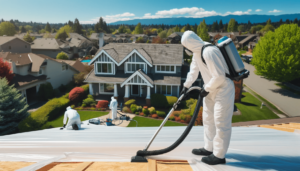
Residential Asbestos Removal
Navigating Asbestos Removal in Residential Settings: Safety, Legalities, and Procedures
Asbestos, a term that often evokes concern, was a popular building material in homes for much of the 20th century, praised for its heat resistance and insulating properties. However, we now understand the serious health risks associated with asbestos exposure, including lung cancer and mesothelioma. In residential settings, where we spend much of our time, the safe removal of asbestos is not just a regulatory requirement; it’s a crucial step towards ensuring a safe and healthy living environment.


The History and Hazards of Asbestos in Homes
Our story begins with an understanding of the extensive use of asbestos in residential buildings. From the 1930s to the late 1970s, asbestos was a go-to material for home builders, used in everything from roof shingles to floor tiles and insulation. The health hazards of asbestos, particularly when it’s disturbed, lie in its fine fibres, which, once airborne, can be inhaled, leading to severe respiratory issues over time.
Recognising Asbestos in Your Home
Identifying asbestos in your home can be challenging. It was used in numerous building materials, some of which are not immediately obvious. Asbestos-containing materials (ACMs) in homes include but are not limited to, textured coatings (like Artex), insulation boards, floor and ceiling tiles, and cement products. Understanding the age of your home and the materials used in its construction can offer clues to the presence of asbestos.
Health Risks and the Importance of Safe Removal
The primary concern with asbestos is its impact on health. Disturbing asbestos-containing materials during renovations or repairs can release fibres into the air. Inhaling these fibres over time can lead to serious health complications, underscoring the importance of safe removal practices.
Identifying and Assessing Asbestos in Your Home
Before any renovation or demolition work, it’s crucial to ascertain whether asbestos is present in your home. This process involves a thorough inspection and often requires the expertise of professionals.
The Role of Professional Asbestos Surveys
An asbestos survey conducted by a qualified professional is the most reliable way to identify ACMs in your home. There are two main types of surveys: the Management Survey, which is standard for residential properties, and the Refurbishment and Demolition survey, which is necessary if significant renovation or demolition work is planned.
Understanding Survey Reports and Risk Assessments
Once a survey is completed, the findings are documented in a detailed report. This report not only identifies where asbestos is located but also assesses its condition and the potential risk it poses. Understanding this report is crucial for homeowners, as it guides the decision-making process regarding asbestos management or removal.
DIY Inspection: Cautions and Limitations
While some homeowners might consider conducting a DIY inspection for asbestos, it’s important to recognise the limitations and risks of this approach. Identifying and assessing asbestos can be challenging and risky without proper training and equipment. Therefore, a professional assessment is generally recommended, especially before undertaking any work that might disturb potential ACMs.
Choosing the Right Asbestos Removal Strategy
Assessing Type, Condition, and Location
Once asbestos has been identified in your home, the next crucial step is deciding on the appropriate removal strategy. This decision hinges on several factors, including the type, condition, and location of the asbestos-containing materials (ACMs).
Professional Removal vs. DIY: Weighing the Risks
While some homeowners might contemplate removing asbestos themselves, especially in cases of minor repairs or small amounts of non-friable asbestos, it’s important to weigh the risks carefully. Professional removal is strongly advised for most situations, as experts have the necessary equipment, training, and legal understanding to handle asbestos safely.
Understanding the Removal Process
The professional asbestos removal process involves several key steps: sealing off the affected area to prevent contamination, using specialised tools and equipment to safely remove the asbestos, and conducting thorough decontamination afterwards. It’s a meticulous process that prioritises safety and compliance with legal standards.
The Legalities and Safety Regulations in Asbestos Removal
Understanding Legal Requirements for Asbestos Removal in the UK
Navigating the legal landscape surrounding asbestos removal is crucial. In the UK, various regulations govern the handling and disposal of asbestos to protect public health and the environment.
Complying with Health and Safety Regulations
The Control of Asbestos Regulations 2012 outline strict guidelines for managing and removing asbestos in residential properties. This includes mandatory notifications to the relevant local authorities for certain types of asbestos work and compliance with safety standards during the removal process.
The Importance of Hiring Licencing Professionals
Hiring a licenced asbestos removal contractor is not just a recommendation—it’s often a legal requirement, especially for more hazardous forms of asbestos. Licensed professionals are equipped to handle asbestos in compliance with all health and safety guidelines, significantly reducing the risk of exposure.
Managing Asbestos Waste and Post-Removal Considerations
Ensuring Environmental Safety
Once the asbestos has been removed, managing the waste correctly is paramount. Asbestos waste must be disposed of in a manner that prevents any release of fibres into the environment.
Safe Disposal of Asbestos Materials
Asbestos waste should be wetted, sealed in heavy-duty plastic bags, and clearly labelled before being transported to a licenced disposal site. Homeowners should rely on their chosen contractor to handle this process, as they will have the knowledge and resources to do it safely and legally.
Ensuring Post-Removal Safety
After asbestos removal, it’s important to ensure that the area is safe for reoccupation. This often involves air monitoring and a thorough cleaning of the premises by the removal contractor. Only once the area has been declared safe and free of asbestos fibres should it be reoccupied.
In conclusion, while asbestos removal from residential properties can be daunting, understanding the process and relying on professional expertise make it manageable. From identifying the presence of asbestos to choosing the right removal strategy and navigating the legal landscape to ensuring safe disposal and post-removal safety, each step is critical to safeguarding your health and that of your family. Remember, dealing with asbestos is not just a regulatory compliance issue but a significant health matter, and it deserves your utmost attention and care.

